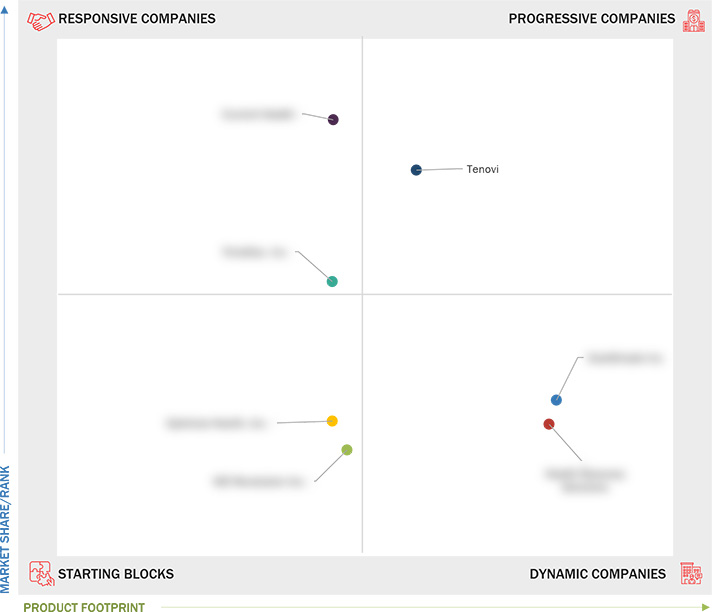Comparing 7 vendors in Remote Patient Monitoring Startups across 0 criteria.
✅ What You Get with This Report
- 📊 Comprehensive Company Analysis - Business strategy, SWOT, financials, growth areas, M&A moves
- 🏆 Market Position & Share Insights - Visual competitive landscape (like the quadrant above)
- 🔍 Segment-level Benchmarking - Product, region, and end-user vertical
- 📁 Image & Report PDF Downloads - Ready-to-use for presentations and strategy sessions
- 📈 Demand Generation [Optional Buy] - License quadrant to drive demand & showcase leadership
✅ Analyst-led
✅ One-time payment
👉 Get Instant Access
1 INTRODUCTION
1.1 Study Objectives
1.2 Market Definition
1.3 Market Scope
1.3.1 Market Segmentation
1.3.2 Inclusions & Exclusions
1.3.3 Years Considered
1.3.4 Currency Considered
1.4 Limitations
1.5 Stakeholders
1.6 Summary of Changes
2 MARKET OVERVIEW
2.1 Introduction
2.1.1 Drivers
2.1.1.1 Transformation of patient care through digital innovation
2.1.1.2 Expansion of telehealth in remote patient monitoring
2.1.1.3 Rising prevalence of chronic diseases
2.1.1.4 Increasing geriatric population and rising uptake of RPM services
2.1.1.5 Growing need for cost-containment across healthcare facilities
2.1.1.6 Technological innovation in wearables, mHealth apps, and connected devices
2.1.2 Restraints
2.1.2.1 High investments and lack of IT expertise
2.1.2.2 Behavioral barriers and healthcare affordability challenges
2.1.2.3 Challenges associated with 2024 CMS regulations
2.1.3 Opportunities
2.1.3.1 Emergence of AI & ML
2.1.3.2 Gradual shift toward outpatient care environments
2.1.3.3 Increasing utilization for infectious disease diagnostics
2.1.3.4 Rising initiatives for hospital-at-home programs
2.1.4 Challenges
2.1.4.1 Concerns associated with data security
2.1.4.2 Data accessibility issues
2.1.4.3 Incorporation of SDOH factors into RPM programs
2.2 Trends/Disruptions Impacting Customers’ Businesses
2.2.1 Revenue Shifts and New Revenue Pockets for RPM Market
2.3 Industry Trends
2.3.1 Gradual Shift to Value-Based & Patient-Centric Care
2.4 Ecosystem Analysis
2.5 Value Chain Analysis
2.6 Technology Analysis
2.6.1 Key Technologies
2.6.1.1 Miniature wearable devices
2.6.1.2 AI & ML
2.6.1.3 Cloud computing
2.6.1.4 Patient engagement tools
2.6.1.5 EHR integration
2.6.1.6 Voice assistant integration
2.6.2 Complementary Technologies
2.6.2.1 5G connectivity
2.6.2.2 mHealth apps
2.6.2.3 Digital therapeutics
2.6.2.4 Telehealth platforms
2.6.3 Adjacent Technologies
2.6.3.1 POC diagnostics
2.6.3.2 Smart home health devices
2.7 Trade Analysis
2.7.1 Trade Analysis for RPM Devices (HS Code: 90189099)
2.7.2 Trade Analysis for RPM Devices (HS Code: 9021)
2.7.3 Trade Analysis for RPM Devices (HS Code: 9022)
2.8 Porter’s Five Forces Analysis
2.8.1 Threat of New Entrants
2.8.2 Threat of Substitutes
2.8.3 Bargaining Power of Manufacturers
2.8.4 Bargaining Power of Buyers
2.8.5 Intensity of Competitive Rivalry
2.9 Patent Analysis
2.9.1 Patent Publication Trends
2.9.2 Jurisdiction and Top Applicant Countries
2.9.3 Leading Patents in the RPM Market
2.10 End-User Analysis
2.10.1 Unmet Needs
2.10.2 End-User Expectations
2.11 Key Conferences and Events, 2025−2026
2.11.1 Detailed List of Events
2.12 Investment and Funding Scenario
2.13 RPM Business Model
2.13.1 Subscription-Based Models
2.13.2 Platform as a Service (PaaS)
2.13.3 Freemium Models with Premium Features
2.13.4 Collaborative Ecosystems & Partnerships
2.14 Impact of Generative AI/AI on the RPM Market
2.14.1 Key Use Cases
2.14.2 Case Studies
2.14.2.1 Cancer Treatment Enhancement with NLP
2.14.2.2 AI for Infection Prevention
2.14.3 Impact on Adjacent Ecosystems
2.14.3.1 Telehealth & Telemedicine
2.14.3.2 Wearable Devices
2.14.3.3 Digital Healthcare
2.14.3.4 Home Healthcare
2.14.4 User Readiness & Impact Assessment
2.14.4.1 Hospitals
2.14.4.1.1 Implementation
2.14.4.1.2 Impact
2.14.4.2 Ambulatory Surgery Centers
2.14.4.2.1 Implementation
2.14.4.2.2 Impact
2.15 Reimbursement Scenario
3 COMPETITIVE LANDSCAPE
3.1 Overview
3.2 Key Player Strategies/Right to Win
3.2.1 Overview of Strategies Adopted by Key Players in Remote Patient Monitoring Market
3.3 Revenue Analysis (2019–2023)
3.4 Market Share Analysis (2023)
3.5 Company Evaluation Matrix: Startups/SMEs (2023)
3.5.1 Progressive Companies
3.5.2 Responsive Companies
3.5.3 Dynamic Companies
3.5.4 Starting Blocks
3.5.5 Competitive Benchmarking: Startups/SMEs (2023)
3.5.5.1 Detailed List of Key Startups/SMEs
3.5.5.2 Competitive Benchmarking of Startups/SMEs
3.6 Company Valuation & Financial Metrics
3.6.1 Financial Metrics
3.6.2 Company Valuation
3.7 Brand/Software Comparison
3.8 Competitive Scenario
3.8.1 Product/Service Launches & Approvals
3.8.2 Deals
3.8.3 Expansions
3.8.4 Other Developments
4 COMPANY PROFILES
4.1 CARESIMPLE INC.
4.1.1 Business overview
4.1.2 Products/Solutions/Services offered
4.1.3 Recent developments
4.2 TIMEDOC, INC.
4.2.1 Business overview
4.2.2 Products/Solutions/Services offered
4.2.3 Recent developments
4.3 MD REVOLUTION INC.
4.3.1 Business overview
4.3.2 Products/Solutions/Services offered
4.3.3 Recent developments
4.4 OPTIMIZE HEALTH, INC.
4.4.1 Business overview
4.4.2 Products/Solutions/Services offered
4.4.3 Recent developments
4.5 HEALTH RECOVERY SOLUTIONS
4.5.1 Business overview
4.5.2 Products/Solutions/Services offered
4.5.3 Recent developments
4.6 CURRENT HEALTH
4.6.1 Business overview
4.6.2 Products/Solutions/Services offered
4.6.3 Recent developments
4.7 TENOVI
4.7.1 Business overview
4.7.2 Products/Solutions/Services offered
4.7.3 Recent developments
Latest
The Queen's Health Systems Partners with Health Recovery Solutions (HRS) to Launch Remote Patient Monitoring Program
 Nov 2024
Nov 2024 Health Recovery Solutions (HRS)
Health Recovery Solutions (HRS)HealPrecisely™ Selects Health Recovery Solutions as Partner for New Innovative RPM Program
 Nov 2024
Nov 2024 Health Recovery Solutions (HRS)
Health Recovery Solutions (HRS)Health Recovery Solutions, Smart Meter Team Up on RPM Home Solution
 Nov 2024
Nov 2024 Medical Product Outsourcing
Medical Product OutsourcingCompany List



